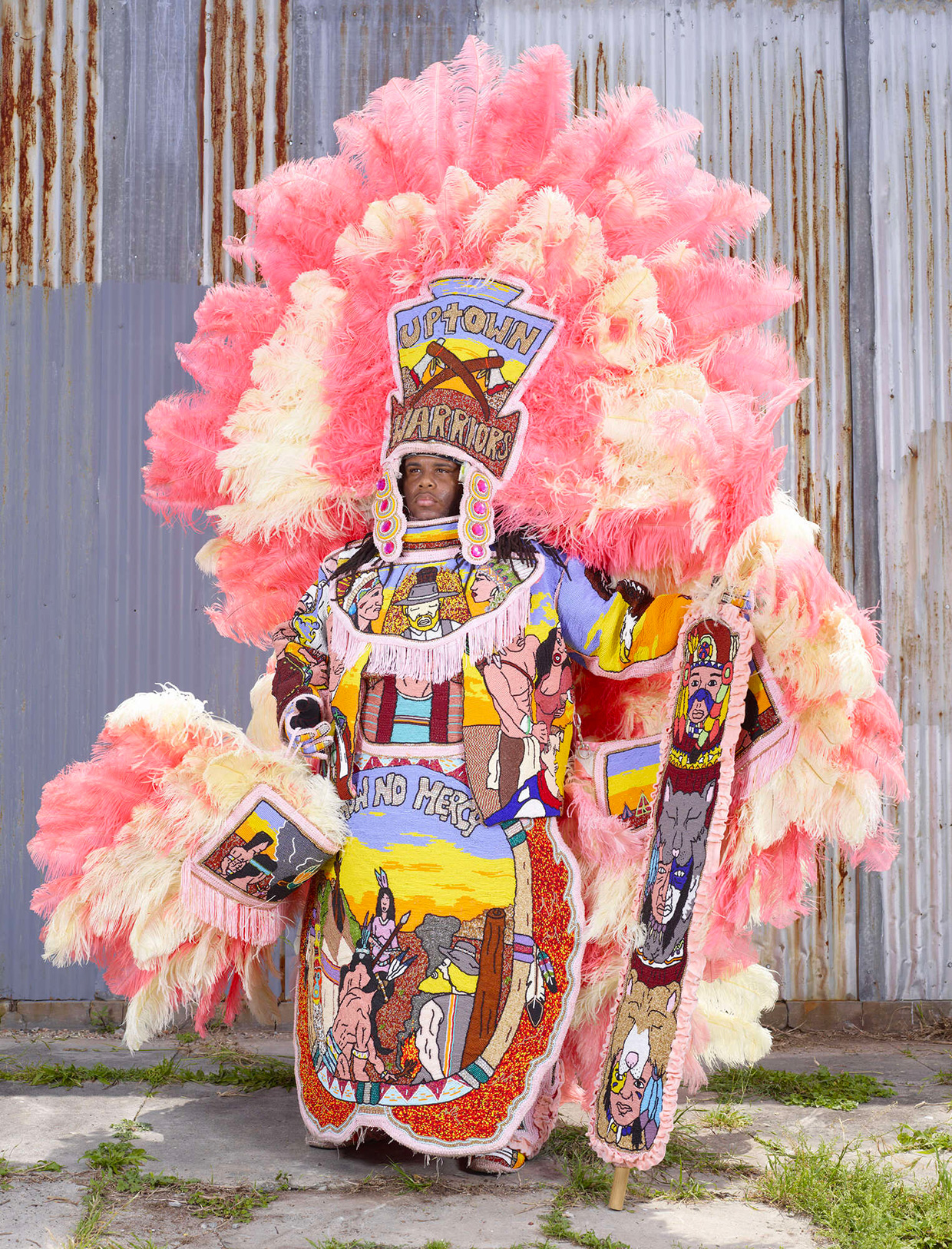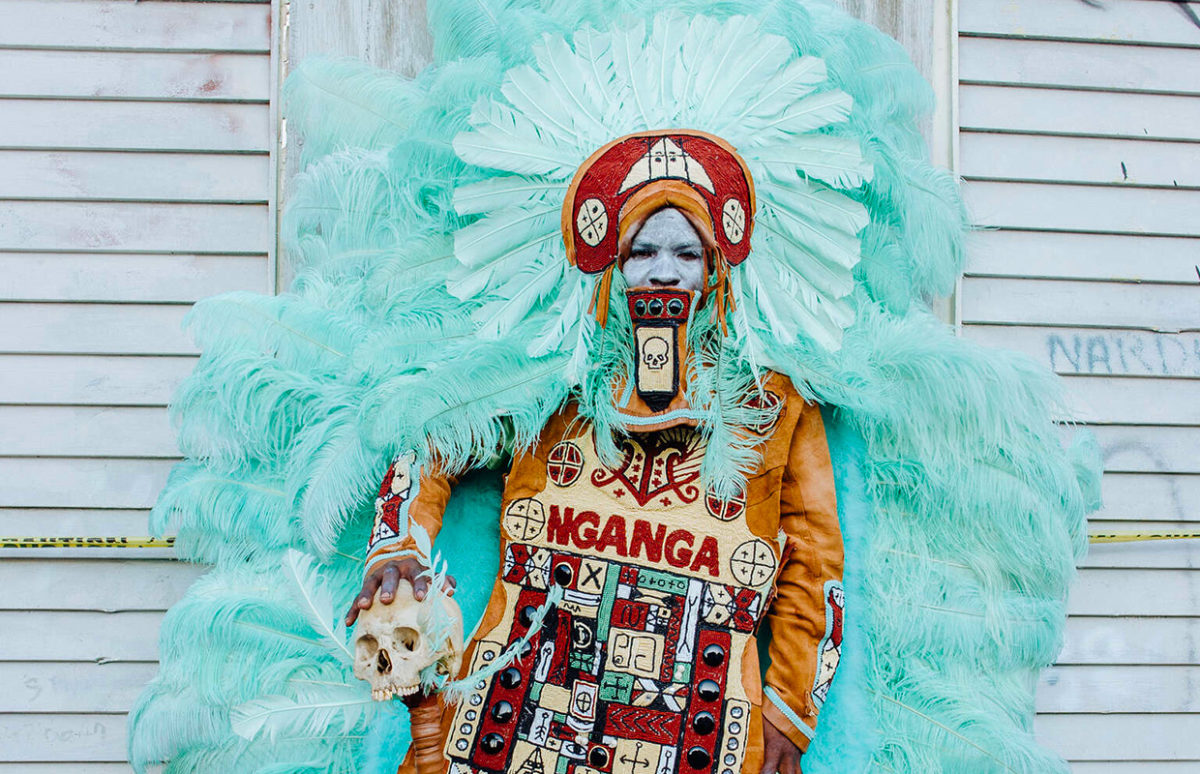The “Black Indian Tribes” or crews are some of the most colourful participants in New Orleans’ famous Mardi Gras celebrations. A new exhibition at the Musée du quai Branly features their intricate, flamboyant costumes and explains the history of African Americans in Louisiana. Till 15 January 2022.
There are more than 40 Black Indian tribes which participate in Mardi Gras. Since black people weren’t welcome in the main celebrations in the 19th century, they created their own traditions. The “Indian” name is a reference to the many Native American tribes which helped escaped slaves. Many Black Indian costumes use Native American motifs and beadwork techniques.

Exhibition Overview
The Black Indians from New Orleans exhibition curated by the Musée du quai Branly, in close cooperation with the Louisiana State Museum, is a vibrant testimony to the violent African-American history in Louisiana and North America : the violence of the capture and uprooting, the crossing and landing in New Orleans, slavery, the Civil War, segregation and racism. This violence shapes their story, leading to resistance strategies, as well as highly complex resilience, social reorganisation, and cultural and artistic processes.
This exhibition is centered on the Mardi Gras carnival in New Orleans, one of the most flamboyant shows of resilience in the face of oppression and a powerful cultural and artistic statement. It was created collaboratively with representatives from Black Indian communities. It is organised in six different sections, both geographically, from the “Old World” to the “New World”, and chronologically, from the first European presence in Louisiana to the present day.
Discovering a new world
The first section introduces Louisiana, its first Native American inhabitants, before it fell under the European sphere of influence. From the 17th century, European settlers subjected Native populations from the Mississippi region to violence due to colonial expansion and the torments of raids, capture, and enslavement. Under French rule, Africans were brought over from the foundation of New Orleans in 1718, to recreate the exploitation and production economic model of Saint-Domingue (Haiti), requiring an ever-increasing unpaid workforce, as Native slaves were in insufficient numbers. Within this shared context of forced labour and oppression, Native Americans developed lasting and respectful ties with newly arrived Africans. Throughout the 19th century, Native American lore, lifestyles, beliefs, and attire were an inspiration to the first Black Indians.

The iron triangle: Europe, Africa and the Americas
This section covers the Louisianian colonisation process, the foundation of New Orleans, and the establishment of a slave-owning society, with the landing of the Aurore frigate in the Gulf of Mexico in 1719. Throughout the French period, over 6 000 slaves were transported to the city. By 1731, about 30% of New Orleans's small population were descended from Africa. The Code Noir was enacted by Colbert, the French Minister for Finance, in 1685. It defined the legal status of slaves and imposed Christianity as their religion; it was applied in Louisiana from 1724. As the Catholic church forbade farm work on Sundays, from 1750, black slaves from diverse countries, multi-racial people, and Native Americans started gathering on “Place des Nègres”, later known as Congo Square. They gathered to trade, dance, play music, and discuss survival strategies. This time away from servitude promoted a type of resilience expressed in renewed cultural, religious, and artistic practices such as the creole language and Voodoo. To the sound of the drums, dances, music, and singing forged New Orleans' identity.
Towards a new country
The third section recounts the transition from a European administration of America towards the founding of the United States in 1776. The Treaty of Paris in 1763 ended the Seven Years’ War between France, Spain, and Britain. With this treaty, France ceded its New France colonial territories to Britain, which lead to the forced displacement of Arcadians to Louisiana and the Antilles. This “Great Expulsion” was the first stage in the emergence of Cajun culture. Unable to hold on to the entirety of the New France, France made a secret pact with its Spanish ally to keep the Western part of Louisiana from falling under British control. The area was returned to France by Spain in 1800. The year 1803 was a turning point in the French adventure in America: all ambitions of founding a colonial empire in the Western hemisphere were abandoned. Weakened by costly military campaigns in Europe, and under pressure from the Founding Fathers of the recently created United States, Napoleon Bonaparte agreed to Louisiana Purchase, the sale of the French colony, and to renounce French imperial aspirations in the New World. The purchase was a foundational event in the creation of the new nation of the United States. Covering a territory which accounts for close to a quarter of the current United States, the Louisiana Purchase connected the Atlantic and Pacific territories.
The United States and the question of race
If, for the most part, European empires profited from the enslavement of Africans, the creation of America relied on the labour of these same populations. Freed from British tutelage, the new country only renounced this exploitation after a bloody civil war and the murder of President Abraham Lincoln in 1865. Supremacist ideology, by which a superior, white Protestant race had been chosen by God to exploit men whose skin colour indicated their inferior status or even intellect, perpetuated particularly in the South with the establishment of Jim Crow laws, the founding of supremacist groups such as the White League of Louisiana, the Ku Klux Klan, and the practice of Convict Leasing, a system in which prisoners were leased out for forced labour. To speed up Reconstruction efforts after the Civil War, tens of thousands of African Americans were prosecuted and sentenced to forced labour in farms, mines, or road and railway construction by complicit Southern legal systems, for petty offenses such as spitting on the ground or walking on a lawn.
Hurricane Katrina
Hurricane Katrina, on 29 August 2005, marked a decisive turn in the history of New Orleans. This meteorological, social, and cultural disaster was unusually violent and struck the African American community hardest, these neighbourhoods being the most vulnerable to hurricanes in this highly segregated city. Most majority-black areas were flooded during the storm, due to the failure of the poorly maintained flood defence system. Having been all but abandoned by public authorities or dispersed around Louisiana and nearby states, residents soon undertook the challenging reconstruction of their neighbourhoods and communities. As soon as the following year, with the 2006 Carnival, Black Indians paraded, thus demonstrating their extraordinary resilience and affirming yet again the importance of this form of cultural expression.
Art, spectacle, and spirituality
The last section of the exhibition celebrates the main African American celebratory and cultural traditions in New Orleans through costumes, objects, video and audio recordings. A powerful unifying force, a source of pride and collective identity, the Black Indians’ Carnival is the high point of these rich traditions. The Carnival, which takes over the street and public space, states the presence and importance of African American communities from and within the city. Among feathers, sequins, and colourful beads, through singing, music, and dancing bodies, profound spiritual values are hidden or expressed openly – values and beliefs taken from African, Voodoo, Catholic, and Islamic religions, as well as Native American and individual imaginings. This tradition, which hails from Congo Square, is a dazzling demonstration of the Black Indians’ resilience, a melding of uprooted cultures that were to become fully-fledged elements of American culture.

Black Indians de la Nouvelle Orléans
Musée du quai Branly – Jacques Chirac, in close cooperation with the Louisiana State Museum
4 October 2022 to 15 January 2023
 Find out more about Louisiana's unique culture in File 27 Colours of Louisiana in Shine Bright LLCER AMC.
Find out more about Louisiana's unique culture in File 27 Colours of Louisiana in Shine Bright LLCER AMC.
Copyright(s) :
Top image: Mystic Medicine Man
© Collection of Jean-Marcel St Jacques
© Photo by Danielle C. Miles
Charles Fréger (né en 1975)
Mardi Gras Indians, 2014
Tirage couleur impression jet d’encre sur papier plastifié aspect satiné
Musée du quai Branly – Jacques Chirac, Paris - Jacques Chirac, Paris
Victor Harris, Esprit de Fi Yi Yi et Big Chief des Mandigo Warriors
© Jeffrey David Ehrenreich
Charles Fréger (né en 1975)
Mardi Gras Indians, 2014
Tirage couleur impression jet d’encre sur papier plastifié aspect satiné
Musée du quai Branly – Jacques Chirac, Paris - Jacques Chirac, Paris
Tag(s) : "black history" "black indians" "costumes" "exhibition" "Indians" "Mardi Gras" "Native Americans" "New Orleans" "Shine Bright AMC"






